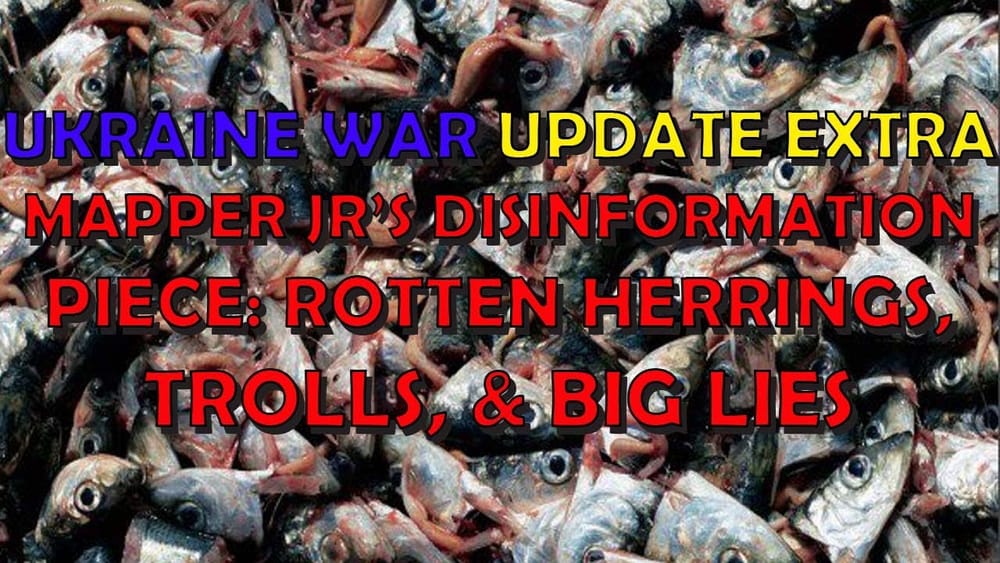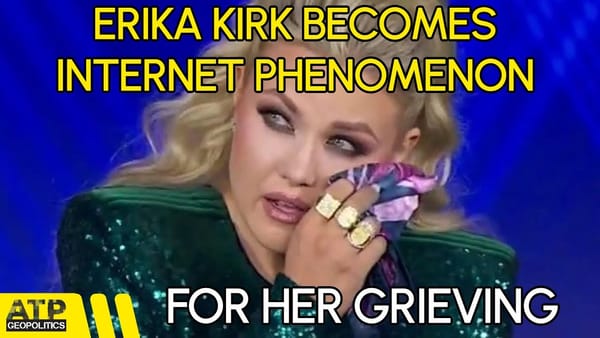Ukraine War Upd. EXTRA: JR's Disinformation Piece - Rotten Herrings, Trolls, & Big Lies
Table of Contents 📖
"Boston state actors are not interested in open debate but aim to cause social unrest. There is a big difference between a personal opinion and organised disinformation campaigns."
Hello Team
🎦 00:00-00:47⏩
Jonathan welcomes viewers to an "extra" video focusing on "tidbits and nuggets" for deeper understanding. He jokes about celebrating "Rishi Vanker Day" with Zelensky, highlighting a lighthearted moment.
Return to top⤴️
Ukrainian Crimean Tatar, Artur Yakubov, Dies Defending Ukraine
🎦 00:47-02:36⏩
Jonathan discusses the death of Artur Yakubov, a Crimean Tatar Imam, who died defending Ukraine. He highlights Yakubov's background, teaching at the Crimean Tatar Lyceum in Kyiv and volunteering in frontline regions. Jonathan uses this to illustrate the diversity of those fighting for Ukraine, countering the "Ukrainian Nazi" narrative. He emphasizes the Crimean Tatars' preference for Ukraine over Russia, despite being a predominantly Muslim minority.
Return to top⤴️
JR's Disinformation Deep Dive: The Power of State-Sponsored Narratives
🎦 02:36-04:01⏩
Jonathan introduces a comment from JR that delves into the effectiveness of disinformation, particularly from state actors like Russia. He praises JR's insight, likening it to an article and highlighting its significance.
Return to top⤴️
Russia's Disinformation Arsenal: From State Media to Troll Factories
🎦 04:01-05:07⏩
Jonathan, reading from JR's comment, details Russia's methods for spreading disinformation, including state-sponsored media like RT and Sputnik, as well as troll farms like the Internet Research Agency (IRA). He cites a Wired article revealing the IRA's growth to 400 employees by 2023, a quarter of whom focused solely on writing manipulative social media comments.
Return to top⤴️
Beyond Bots: AI, Fake Websites, and Narrative Laundering
🎦 05:07-07:40⏩
Jonathan expands on JR's points, noting disinformation goes beyond simple comments and bots. He explains how AI generates content, and fake websites act as fronts for "narrative laundering". He illustrates this with a hypothetical "embroidery blog" used to subtly inject pro-Russian narratives amidst seemingly innocuous content, leading unsuspecting readers down a "rabbit hole".
Return to top⤴️
The Erosion of Trust: Disinformation's Impact on Democracy and Society
🎦 07:40-08:45⏩
Jonathan, quoting JR, emphasizes the deliberate and large-scale nature of these disinformation campaigns. Their purpose, he stresses, is to sow division, promote conspiracy theories, and undermine democratic institutions. JR likens this to a form of warfare requiring government response to protect citizens while upholding free expression. Jonathan strongly agrees, highlighting how viewers commenting on his videos, even positively, contribute to the information war by boosting its visibility. He encourages engagement as a way to combat pro-Russian narratives.
Return to top⤴️
Case Study: Russian Interference in the US Women's March
🎦 08:45-12:02⏩
Jonathan cites a Times investigation revealing Russian entities' involvement in the US Women's March. He explains how Kremlin-backed accounts, disguised as Americans with varying viewpoints, aimed to sow discord and discredit the movement. He questions whether any viewers were unknowingly influenced by these trolls, highlighting the insidious nature of such tactics.
Return to top⤴️
Spotting Twitter Trolls: Obsession, Reactionary Behaviour, and Blue Ticks
🎦 12:02-13:21⏩
Jonathan shares tips for identifying trolls on Twitter, particularly those with blue ticks. He notes their often singular focus on one topic, reactionary commenting style, and lack of original content. He gives an example of a suspected troll whose sole purpose seemed to be amplifying divisive opinions.
Return to top⤴️
Amplifying Fringe Views: Shifting the Overton Window
🎦 13:21-14:37⏩
Jonathan explains that Russian disinformation often involves amplifying existing grievances or fringe views to make them appear mainstream. By creating the illusion of widespread support, these campaigns manipulate public perception and shift the Overton window, normalizing extreme viewpoints.
Return to top⤴️
The Mere Exposure Effect: Normalizing the Unacceptable
🎦 14:37-17:26⏩
He links this to the "mere exposure effect," a psychological phenomenon where repeated exposure, even to negative stimuli, increases acceptance. He illustrates this with examples like Nigel Farage's frequent appearances on BBC's Question Time and Donald Trump's constant media presence, arguing that visibility, even if negative, can legitimize divisive figures and their ideas.
Return to top⤴️
US Election Interference: Suppressing the Black Vote
🎦 17:26-18:06⏩
Jonathan cites a 2018 US Senate report confirming Russian troll farms posed as Black Americans online to suppress the Black vote during the 2016 election. This further illustrates the targeted nature of Russian disinformation, aiming to influence specific demographics.
Return to top⤴️
Identifying Disinformation Actors: Exploiting Identity for Manipulation
🎦 18:06-21:08⏩
He shares his observations of YouTube and Twitter accounts using identity markers ("Turkish working class single mum," "Black guy who voted for Joe Biden") as tools for manipulation. He suggests these accounts exploit shared identities to make divisive rhetoric more palatable to target audiences.
Return to top⤴️
Drowning Out Dissent: The Denk Case in the Netherlands
🎦 21:08-22:51⏩
Jonathan shifts to the tactic of suppressing opposing viewpoints. He cites a case from the Netherlands where the Denk party planned a fake news campaign to discredit the right-wing PVV party during the 2017 elections. He highlights the party's alleged links to the Turkish government, illustrating foreign influence in domestic politics.
Return to top⤴️
The "Right" to an Opinion: Jonathan's Philosophical Challenge
🎦 22:51-24:50⏩
Jonathan challenges the notion of an inherent "right" to an opinion, particularly when it promotes harmful disinformation. He argues that unjustified opinions hold little value and can be dangerous, citing the potential for inciting violence or spreading harmful ideologies. He suggests that opinions require justification to be considered valid, advocating for reasoned discourse over the blind assertion of "rights."
Return to top⤴️
Digital Repression: Coordinated Reporting Attacks and YouTube Censorship
🎦 24:50-25:32⏩
He discusses how platforms like YouTube are susceptible to "digital repression" through coordinated reporting attacks. Pro-Russian groups flag content as violating terms of service, leading to removal and limiting the reach of opposing voices.
Return to top⤴️
More Examples of Russian Disinformation Campaigns
🎦 25:32-31:20⏩
Jonathan provides additional examples of Russian disinformation campaigns:
- A US Congressional report confirms Russia's attempts to interfere in Dutch elections.
- He highlights the use of hacking, leaks, and fake websites disguised as legitimate news sources.
- He references the 80/20 rule, where disinformation (20%) is mixed with genuine information (80%) to appear credible.
- He cites a Guardian article about Russia directing hackers to attack Western targets.
The Spread of Fake News: Faster and More Pervasive than Truth
🎦 31:20-33:18⏩
He emphasizes how fake news spreads faster and further than real news, citing research showing it travels six times faster on social media. This rapid dissemination exacerbates the impact of disinformation campaigns.
Return to top⤴️
Deep Fakes and Information Laundering: A Case Study
🎦 33:18-34:13⏩
Jonathan returns to the topic of "information laundering." He revisits a previous example involving a fabricated story about Zelensky owning a luxurious villa, illustrating how disinformation originates from obscure sources, gets amplified by pro-Russian actors, and eventually finds its way into mainstream media, legitimizing the initial lie.
Return to top⤴️
Combating Disinformation: Education and Media Literacy
🎦 34:13-35:34⏩
Jonathan stresses the importance of media literacy as a defense against disinformation. He cites Finland's proactive approach of integrating disinformation awareness into their education system. He emphasizes the need to critically evaluate information sources and recognize manipulation tactics.
Return to top⤴️
More Examples of Russian Disinformation Tactics
🎦 35:34-47:01⏩
- Jonathan presents more evidence on the use of bots to amplify pro-Russian messages.
- He cites his own article on "epistemic security," highlighting the threat disinformation poses to our understanding of truth and its potential to hinder responses to future crises.
Russian Propaganda Techniques: Rotten Herrings, Big Lies, and More
🎦 47:01-52:20⏩
Jonathan shares a quote from a Ukrainian-American artist who cites a Russian journalist's description of propaganda techniques taught at Moscow State University. These techniques, now used against civilian populations, include: * The Rotten Herring Method: Discrediting an individual by associating them with a scandalous accusation, regardless of its truth. * The 40/60 Principle: Gaining trust by presenting 60% truth and then injecting 40% disinformation. * The Big Lie Method: Fabricating a lie so outrageous that people struggle to believe anyone would lie about it. * The Absolutely Obvious Method: Presenting lies as self-evident truths. Jonathan draws parallels to philosophical concepts like "poisoning the well" and discusses how these tactics manipulate public perception.
Return to top⤴️
The Big Lie: The US Election Fraud Example
🎦 52:20-59:06⏩
Jonathan dissects the "Big Lie" technique, using the US election fraud claims as a prime example. He argues that despite court rulings, settlements, and admissions of falsehood by figures like Tucker Carlson, many remain convinced of widespread fraud. Jonathan explains this through cognitive dissonance reduction—individuals clinging to beliefs even when confronted with contradictory evidence. He questions how many viewers still adhere to the election fraud narrative and invites them to share if their perspectives have changed.
Return to top⤴️
The Sunk Cost Fallacy and Doubling Down on Lies
🎦 59:06-59:52⏩
He links the persistence of these beliefs to the sunk cost fallacy, where people continue investing in a decision despite mounting evidence of its failure. He suggests that admitting to being misled for years is a difficult pill to swallow, leading individuals to double down on their beliefs.
Return to top⤴️
The Need to Combat Disinformation from All Sources
🎦 59:52-54:30⏩
Jonathan argues that while we condemn Russia's disinformation campaigns, similar tactics are employed by domestic politicians with seemingly little consequence. He questions the lack of accountability for politicians spreading lies, drawing a parallel to regulations against false advertising. He concludes that we need effective measures to combat disinformation, both from foreign and domestic actors.
Return to top⤴️
Freedom of Speech vs. Freedom to Manipulate: A Philosophical Quandary
🎦 54:30-54:55⏩
Jonathan grapples with the tension between freedom of speech and the freedom to manipulate through lies. He argues that unchecked disinformation undermines the very foundation of a functioning society, advocating for a nuanced approach that balances free expression with safeguards against harmful manipulation.
Return to top⤴️
Wrap up
🎦 54:55-end
He acknowledges the complexity of the issue, emphasizing that there are no easy answers. He expresses gratitude to JR for his insightful comment, leaving viewers with "food for thought" on combating disinformation in an age of information warfare.
Return to top⤴️



